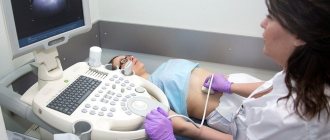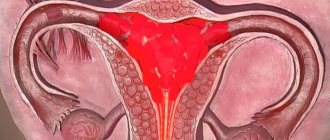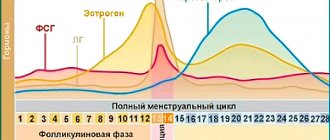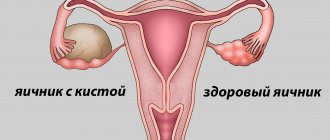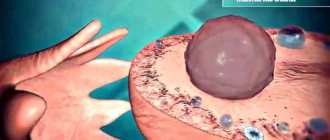The duration of the menstrual cycle is usually from 23 to 35 days. Shorter or longer intervals between the first day of bleeding and the last day before the start of the next menstruation are a cause for alarm and indicate disturbances in the functioning of the body, of course, with a negative pregnancy test result. Quite often there is a delay with an ovarian cyst. The reason is the excess production of hormones.
If you have an ovarian cyst, there may be cycle disorders
Menstruation with ovarian cyst
Delayed menstruation with an ovarian cyst is a characteristic sign of a progressive disease. It is the absence of regular menstruation that indicates various gynecological pathologies, among which one of the most common is an ovarian cyst. Therefore, if a woman’s menstrual cycle has become irregular, and concomitant symptoms also appear: abdominal pain, increased urge to urinate, impaired bowel movements, etc., you need to make an appointment with a gynecologist as soon as possible and find out the exact diagnosis.
Features of menstruation after surgery
Features of menstruation after laparoscopy surgery
Laparoscopy is an operation to remove benign and malignant neoplasms, cut adhesions, fallopian tubes, restore their patency, and so on. A significant advantage of this type of operation is its low level of trauma to the body. The entire operation is performed through several small holes, which heal quickly and do not leave large, scary stitches.
Menstruation after removal of an ovarian cyst can begin even on the next day (but more often on 5-6) and last up to 2-3 weeks. After laparoscopy, light, clear discharge, possibly with small splashes of blood, is considered normal. This is due to the healing process and should not be a cause for concern.
If intense discharge or blood clots appear, you should inform your doctor (this may be normal in the first days after surgery). This may be evidence of bleeding that began after surgery. A possible infection will be indicated by menstruation that is yellow-green (or brown-green) in color and has an unusual odor. The appearance of Candidiasis fungi is indicated by white discharge, accompanied by burning and itching.
Also after laparoscopy it is possible:
- Changing the duration of the cycle, it can become shorter or longer by several days. After 2-3 cycles it should return to normal.
- The cycle itself is shifting. The gynecologist usually tells the patient that now the beginning of the cycle must be counted from the day of the operation.
- In some cases, there may be a delay for a long time.
The effect of cysts on the menstrual cycle
An ovarian cyst is a tumor of benign etiology, which is a capsule filled with serous fluid. The disease is diagnosed in women of any age, but more often after puberty. While the tumor is small in size, it does not manifest itself in any way. But as it increases, pathological symptoms develop, which should be a reason to see a doctor as soon as possible.
Menstruation with an ovarian cyst becomes irregular, and changes in their character can develop in 2 directions:
- The beginning of a new cycle is delayed, but then prolonged, heavy bleeding appears.
- Menstruation occurs on time, but the discharge is scanty and practically absent.
Failure of the menstrual cycle and ovarian cyst are related, because more often the tumor is of a follicular nature. A benign neoplasm is formed if the mature egg does not leave the follicle in time. In this situation, ovulation does not occur, so the start date of the new cycle moves forward, while the delay period can range from 5 to 30 days.
Follicular cysts are prone to self-resorption. But if this does not happen, the formation increases in size, then with the onset of menstruation the following pathological symptoms begin to worry:
- heavy bleeding that lasts much longer than usual;
- sharp abdominal pain;
- increased gas formation, bloating.
In some cases, menstrual bleeding becomes scanty. This is due to serious hormonal imbalance and the development of a deficiency of specific female hormones. Another type of cyst that affects the menstrual cycle is endometriotic. It occurs with advanced endometriosis, when endometrial cells from the uterus spread to neighboring tissues. Symptoms that develop with such a cyst:
- spotting before menstruation;
- heavy, prolonged menstruation;
- acute pain in the abdomen.
Differential diagnosis of functional cysts
To begin treatment of the disease, the doctor must understand which cyst will have to start working with. In medical practice, a correct diagnosis is the key to successful and rapid treatment of the patient. Characteristic symptoms of a follicular cyst are:
- Lower abdomen hurts (ache).
- During menstruation, the symptoms disappear sharply.
- Discomfort during intimate intercourse.
- Increased body temperature.
- Cold profuse sweat.
- Tissue necrosis.
- Pale skin.
Unlike the follicular cyst, with a corpus luteum cyst the following are observed:
- Constipation.
- Nausea, vomiting.
- Breast enlargement, which is accompanied by soreness of the glands.
- Lower abdominal pain.
- White discharge.
Regulating the cycle with a delay in menstruation
Regulation of the cycle in case of delay caused by the formation of an ovarian cyst is carried out using hormone-containing drugs prescribed by a doctor after confirmation of the diagnosis. To treat the problem, the following medications are most often prescribed:
- "Duphaston" or "Utrozhestan". Drugs with similar effects. Normalize progesterone levels, promoting normal egg maturation. After a course of therapy, the menstrual cycle stabilizes.
- "Dysmenorm." Homeopathic medicine made on the basis of natural ingredients. Helps normalize the menstrual cycle and eliminate pathological symptoms. The desired effect occurs with long-term use.
- Vitamins C and E. Participate in the synthesis of hormones necessary for the normal functioning of the organs of the reproductive system.
- Oral contraceptives. Stabilize the functioning of the reproductive organs.
If conservative treatment is powerless, the cyst gradually increases in size and the risk of developing negative consequences increases, the doctor discusses surgical treatment options with the patient.
To remove a benign ovarian cyst, the laparoscopic method is most often used. This is a minimally invasive, organ-preserving procedure, during which small punctures are made on the anterior abdominal wall through which a laparoscope and surgical instruments are inserted. All manipulations are visible on the monitor screen. The surgeon removes the capsule with its contents, rehabilitation takes place quickly, at home.
Possible complications of the operation
- Heavy menstruation indicates the onset of uterine bleeding.
- You should not be afraid if you experience slight abdominal pain and blood clots during the first cycle. This is in most cases a normal consequence of the operation, but the gynecologist needs to be informed about this so that he can rule out other causes.
- After surgical treatment, a woman should especially closely monitor the condition of the discharge. They should be the same color as before treatment.
- The smell of the discharge should not change either.
- The appearance of mucus can be a pathological condition or the norm, you need to figure it out.
- The appearance of fever after surgery is evidence of a developing infection that the body is fighting. In this case, you should immediately seek medical help.
The sooner the patient suspects a cyst, the faster she will receive help, which increases the possibility of conservative treatment. In most cases, the cyst is treated with medication; surgery is a backup treatment option for the most serious cases.
Cost of treatment for ovarian cysts
The cost of ovarian cyst therapy for each patient is calculated individually, taking into account the chosen treatment method, the patient’s age, the size and type of tumor, and the individual characteristics of the body.
To clarify prices and make an appointment with a specialist at the Healthy Family multidisciplinary clinic, call +7 (495) 185 93 07 or request a call back. As soon as managers see the request, they will immediately contact you and advise you on all issues of interest.
Do I need to get rid of the cyst or will it disappear on its own?
Medical practice shows that not all types of cysts are amenable to conservative treatment. Without removal, only functional types of formations can be cured:
- Follicular
- Luteal
As long as the tumor of the listed types has not reached a size of 5-7 cm in diameter or more, there is a chance of defeating the disease without surgical intervention. The most important thing in this disease is that only a doctor can confidently say: the tumor needs to be removed or can be treated with medication.
Important! Before prescribing treatment methods for a disease, the patient must undergo a specialized examination to determine the type of disease
There is no clear answer to the question “Can a cyst resolve on its own?” Functional species in the early stages can disappear from the body on their own within 2-3 menstrual cycles. Usually, a woman does not even notice signs of their presence.
What happens to a cyst during menstrual periods?
The pain of the cyst usually appears before the onset of menstruation. In this case, the pain itself manifests itself on the side where the tumor is located. The painful sensations themselves can be either pulling or aching, with some feeling of heaviness. This is due to the fact that the cyst becomes denser during menstruation and can put pressure on neighboring organs. When diagnosing a cyst, it is important to understand that active sexual life can cause the pain to become constant, as well as torsion of the ovary or pedicle itself.
It is extremely important to remain calm during physical activity and not make sudden body movements. This can contribute not only to a change in the location of the tumor, but also to its rupture.
The condition of the pathological neoplasm requires regular consultations and examinations with a doctor, since only he can explain what is happening with the cyst and what disturbing symptoms are associated specifically with its presence.
This may include a feeling of fermentation and rumbling in the stomach, as well as a frequent urge to go to the toilet, since the growing tumor can put pressure on the ovary itself, as well as on the bladder.
What can happen when a cyst ruptures?
Another option for the development of pathology concerns the fact that the cyst may burst. In this case, there is a sharp pain in the lower abdomen, nausea and vomiting, as well as chills. The pain usually radiates to the anus and tailbone. A burst cyst of the luteal or endometroid type provokes hemorrhage into the abdominal cavity, which causes peritonitis and requires emergency medical care with surgery to remove dangerous fluid from the abdominal cavity.
Ruptures of follicular cysts are less dangerous, but they also leave severe pain and require the help of a doctor.
How can the development of a cyst manifest itself?
Delay (in the absence of pregnancy) is considered the main symptom of cystic formations. However, other manifestations may also occur:
- nagging or aching pain on the right or left side, depending on which side the formation appeared on,
- bleeding, for example, after sexual intercourse, lifting something heavy or making a sharp turn,
- after a delay in menstruation occurs due to an ovarian cyst, menstruation lasts more than 7 days,
- in most patients the discharge becomes profuse,
- In some women, under the influence of hormones, menstruation, on the contrary, is quite scanty,
- At any stage of the cycle, spotting appears.
If there is even the slightest chance that a woman is developing a cyst, it is imperative to undergo an examination. When the formation is small, the doctor may choose a wait-and-see approach, conservative therapy and periodic examinations. If the cyst is large enough, or the period of absence of critical days exceeds more than a month, surgical treatment may be required.
